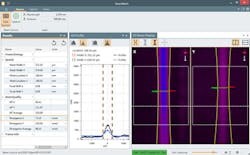| A high-power laser beam is measured in two axes simultaneously by Ophir-Spiricon's BeamWatch 2.0. (Image: Ophir-Spiricon) |
The Ophir-Spiricon (North Logan, UT) BeamWatch instrument, which characterizes laser beams up to 100 kW in a noncontact approach based on Rayleigh scattering of light, has added a second axis to its measurements; now, a high-power beam can be viewed and measured in two orthogonal axes. The BeamWatch 2.0 was unveiled at the Laser World of Photonics 2015 exhibition (22 to 25 June, 2015; Munich, Germany).
BeamWatch is designed for very high-power YAG, fiber, and diode lasers used in industrial materials-processing applications such as welding and cutting operations in automotive, heavy equipment, and appliance manufacturing, and in oil and gas drilling. In the dual-axis version of the Beamwatch, measurements are calculated on each axis, providing detailed information about how the laser is operating. Focal shift can be tracked on both axes and the measurements can be used to determine the roundness of the beam or the presence of astigmatism. The instrument has high-magnification optics that measure beams with spot sizes down to 55 µm for the single-axis version and 155 µm for the dual-axis version.
Measurements every 60 ms
Because there is no contact with the laser beam, BeamWatch has no power restrictions. Conventional beam measurement systems place a probe in the beam, causing potential damage and slowing the measurement process to as long as two minutes to gather data and characterize the beam. BeamWatch takes measurements every 60 ms, providing fast readings of focus spot size and beam position, as well as dynamic measurements of focal-plane location during process start-up.
"Welding and cutting are increasingly complex processes with many factors affecting spot size, including laser power, focal spot size, shape, position, and shift," said Gary Wagner, General Manager, Ophir Photonics (U.S.). "Take the new, remote, 'on-the-fly' welding techniques, as an example. In these applications, it is essential to know where the focus spot is after manipulation within the weld area. BeamWatch's dynamic focus shift capabilities allow for instant readings and, therefore, rapid correction of large-area cosine changes. This means smaller, higher-accuracy welds and cuts and reduced variability across parts."
BeamWatch monitors high power YAG, fiber, and diode lasers in the 980-1080 nm range. The system measures key beam size, position, and quality parameters, including focus spot size, waist width, and beam-propagation parameter (M2). It can be run in so-called "technician mode," where access is provided to the tools needed for start-up and advanced beam diagnostics, or in "operator mode," where the run-time interface helps operators quickly understand the status of the laser's performance without having to interact with the laser or the monitoring system. BeamWatch also includes tools to implement an automation server written in Visual Basic for Applications (VBA), C/C++, or ActiveX applications such as LabVIEW or Microsoft Excel.
The BeamWatch family includes three versions that provide 2D viewing of 155 µm (and larger) focus spots, 1D viewing of 55 µm (and larger) focus spots, and 1D viewing of 155 µm (and larger) focus spots, respectively.
For more info, see http://www.ophiropt.com/photonics and http://ow.ly/OxJvK
Source: Ophir-Spiricon
